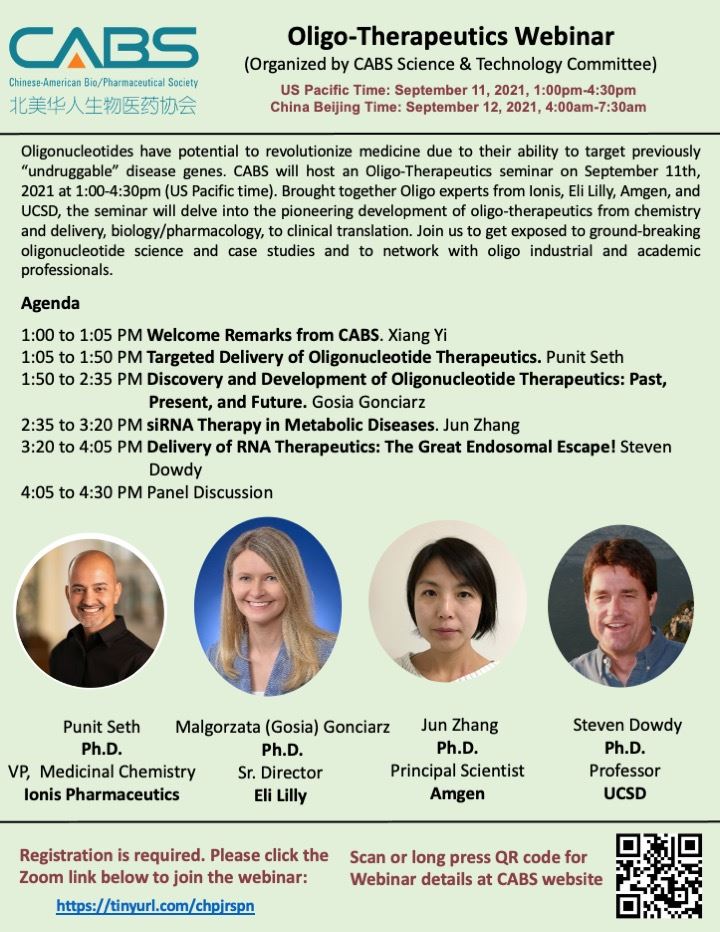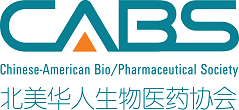CABS Oligo-Therapeutics Webinar
Date: September 11, 2021 @ 1:00 pm – @ 4:30 pm
Location: Zoom
Oligo-Therapeutics Seminar
Organized by CABS Science & Technology Committee
Oligonucleotides have potential to revolutionize medicine due to their ability to target previously “undruggable” disease genes. The Chinese American Bio-Pharmaceutics Society (CABS) will host an Oligo-Therapeutics seminar on September 11th, 2021 at 1:00-4:30pm (PDT). Brought together Oligo experts from Ionis, Eli Lilly, and Amgen, the seminar will delve into the pioneering development of oligo-therapeutics from chemistry and delivery, biology/pharmacology, to clinical translation. Join us to get exposed to ground-breaking oligonucleotide science and case studies and to network with oligo industrial professionals.
Date: September 11th 2021, Saturday, 1:00-4:30 PM (PDT)
Zoom: https://zoom.us/webinar/register/WN_h_M02eYFSEKTWjN1WEwU7A
Agenda:
1:00 to 1:05 PM PDT Welcome Remarks from CABS. Xiang Yi, PhD, Co-chair, CABS Science & Technology
1:05 to 1:50 PM PDT Targeted Delivery of Oligonucleotide Therapeutics. Punit Seth, PhD, VP of Medicinal Chemistry, Ionis Pharmaceutics, San Diego
Abstract: Synthetic therapeutic oligonucleotides (STO) represent the third bonafide platform for drug discovery in the pharmaceutical industry after small molecule and protein therapeutics. No less than thirteen STOs have been approved by regulatory agencies and over one hundred of them are in different stages of clinical trials. STOs hybridize to their target RNA or DNA in cells via Watson-Crick base pairing and modulate their function to exert pharmacological effects. This unique class of therapeutic agents has the potential to target genes and gene products that are considered undruggable by other therapeutic platforms. However, STOs must overcome several extracellular and intracellular obstacles to interact with their biological RNA targets inside cells. These obstacles include degradation by extracellular nucleases, scavenging by the reticuloendothelial system, filtration by the kidney, traversing the capillary endothelium to access the tissue interstitium, cell-surface receptor-mediated endocytic uptake, and escape from endolysosomal compartments to access the nuclear and/or cytoplasmic compartments where their targets reside. Recent advances in the delivery of STOs will be presented.
1:50 to 2:35 PM PDT Discovery and Development of Oligonucleotide Therapeutics: Past, Present, and Future. Gosia Gonciarz, PhD, SR. Director, Internal Platform Leader, New Therapeutic Modality, Eli Lilly and Company, Indianapolis
Abstract: Nucleic-acid based therapeutics are emerging new drug modalities beyond conventional small molecules, peptides and monoclonal antibodies, that offer new therapeutic avenues and solutions for unmet medical needs. Different classes of nucleic-acid therapies including antisense oligonucleotides, aptamers, small interfering RNAs, microRNAs, messenger RNA, viral vectors and CRISPR/Cas9 system are being evaluated in clinical trials or have already received regulatory approval. RNA-based therapeutics can act through different mechanisms ranging from activation to silencing and knockout of the target gene. The versatility of modes of action makes them popular therapeutic agents for various medical needs.
Unmodified RNA molecules are unstable, rapidly degraded and cleared from circulation. After years of dedicated research, major challenges associated with poor potency, stability and immune response activation have been overcome and led to discoveries of potent and durable RNA therapeutics. Antisense oligonucleotides (ASOs) and short interfering RNAs (siRNAs) are the most advanced and promising examples of this newer class of medicines. First wave of RNA therapies has been developed for treatment of rare indications such as spinal muscular atrophy, hereditary TTR-mediated amyloidosis and acute hepatic porphyria as exemplified by regulatory approvals of Spinraza, Onpattro and Givlaari respectively, building excitement and confidence in this new class of therapeutics. The next wave of RNA therapeutics might offer treatments for broader indications such as cardiovascular disease. Recent clinical readouts with inclisiran, an siRNA designed to inhibit the synthesis of the proprotein convertase subtilisin-kexin type 9 (PCSK9) to lower low-density lipoprotein cholesterol (LDL-C), suggest that RNA therapies could offer attractive therapeutic solutions to broad patient populations. As demonstrated in phase 3 clinical trial, a single subcutaneous injection of inclisiran can lower LDL-C level for 6 months. Long duration of action and infrequent administration of siRNA therapies is very attractive from various perspectives, including patient convenience, lower cost of goods and most importantly will significantly improve patient adherence to medication and as a result improve disease outcomes.
2:35 to 3:20 PM PDT siRNA Therapy in Metabolic Diseases. Jun Zhang, PhD, Principal Scientist, Amgen, South San Francisco
Abstract: Since discovery in 1998, RNA interference (RNAi) become a widely used research tool to probe the importance of individual genes by knocking down gene expression. Ten years later, synthetic small interfering RNAs (siRNAs) were discovered with great potential as therapeutics to extend its targets beyond what can be achieved with small molecules and biologic. Recent progress in clinics further suggest that siRNA drugs are safe, effective with extremely long duration of action up to six months, presented revolutionary impact on pharmaceutical industry. These advantages are beneficial to chronic metabolic conditions such as T2D, NASH, cardiovascular disease (CVD), chronic lung conditions, which in general require therapeutics met high standards of safety, effectiveness, and easy administration. A summary of synthetic siRNA-based drug design and progress in therapeutic development will be discussed, with a focus on opportunities and challenges to overcome metabolism related disorders and syndromes.
3:20 to 4:05 PM PDT Delivery of RNA Therapeutics: The Great Endosomal Escape! Steven Dowdy, PhD, Professor, Dept. of Cellular & Molecular Medicine, UCSD, San Diego
Abstract: RNA therapeutics have great potential to selectively treat human disease, especially cancer, pandemics and CNS disorders. Due to their large 8-14 kiloDalton size and 20-40 or more negative phosphate charges, RNA therapeutics are too large to diffuse across the cell membrane and are instead taken up endocytosis. However, >99% of RNA therapeutics remain trapped inside of endosomes with <1% escaping across the endosomal lipid bilayer membrane into the cytoplasm of cells. Consequently, endosomal escape remains The Technological Problem to solve for development and efficient delivery of all RNA therapeutics. Viruses also have an same endosomal escape problem, but have evolved mechanisms to solve it. We developed new chemistry to synthesize a universal endosomal escape domain (uEED) that biomimics the mechanism that enveloped viruses use to escape the endosome. uEEDs can be conjugated to all RNA therapeutics.
4:05 to 4:30 PM PDT Panel discussion
Speakers Background:

Dr. Punit P. Seth heads medicinal chemistry and targeted delivery at Ionis Pharmaceuticals. Dr. Seth is co-inventor of Ionis’ Gen 2.5 platform which employs high affinity nucleoside modifications to enhance the affinity, stability and potency of ASOs in the liver and in extra-hepatic tissues. He is also the co-inventor of Ionis’ LICA (ligand conjugated antisense oligonucleotides) platform which enhances ASO potency by targeted delivery to cells and tissues of interest. He has extensive experience with using medicinal chemistry strategies to modulate the activity, pharmacokinetic and toxicological properties of oligonucleotide drugs. Dr. Seth is listed as co-author/co-inventor on over 200 peer-reviewed publications, issued patents and patent applications. He has a Ph.D. in organic chemistry from The Ohio State University.

Malgorzata (Gosia) Gonciarz is a Senior Director in Lilly’s Novel Therapeutic Modalities organization, where she leads a diverse group of scientists to design and develop RNA based therapeutics and enable their delivery to specific tissues. Dr. Gonciarz received a M.S. in Biochemistry from the University of Wroclaw, Poland and a Ph.D. in Molecular and Cellular Biology from University of Gdansk, Poland. She then went on to post-doctoral work at University of Utah where she studied structure and function of cellular components. Dr. Gonciarz joined Lilly in 2009 and started her journey in Biotechnology Discovery Research organization where she has applied her expertise in protein engineering, structural biology, and biophysical characterization to advance peptide-, protein- and antibody-based therapeutics. Through her various scientific roles at Lilly, she led teams from early discovery through clinical proof-of-concepts advancing Lilly’s pipeline across breadth of therapeutic areas.



Dr. Steven F. Dowdy is a Professor of Cellular & Molecular Medicine at UCSD School of Medicine and a cancer biologist, specializing in the development and delivery of RNA therapeutics, and G1 cell cycle control in cancer. He received his Ph.D. in Molecular Genetics from UC Irvine with Prof. Eric Stanbridge working on tumor suppressor genes, and performed his postdoctoral fellowship with Prof. Bob Weinberg at the Whitehead Institute, MIT, working on the biochemistry of the Rb tumor suppressor gene. His lab is focused on the molecular details of delivery of RNA therapeutics across the endosomal lipid bilayer and the synthesis of endosomal escape domains to overcome this billion year old rate-limiting barrier. His lab was the first to synthesize bioreversible, charge neutralizing phosphotriester backbone RNAi prodrug triggers that increase metabolic stability, pharmacokinetics and enhance endosomal escape. Dr. Dowdy sits on five biotech Science Advisory Boards and is an elected member of the Oligonucleotide Therapeutics Society (OTS) Board of Directors (2015-present). Previously, Dr. Dowdy was a Howard Hughes Medical Institute Investigator (1994-2012) and an Assistant Professor at Washington University School of Medicine, St. Louis (1994-2001).

.
